Pregnant Ichthyosaur Airlifted to Safety
As the glaciers that comprise the Southern Patagonian Ice Field in Chile retreat, some of the rocks exposed have revealed an astonishing array of ichthyosaur fossils. A resilient and dedicated team of scientists have been working to map this hugely significant site and to extract the marine reptile fossil material so that these remarkable specimens can be studied in more detail.
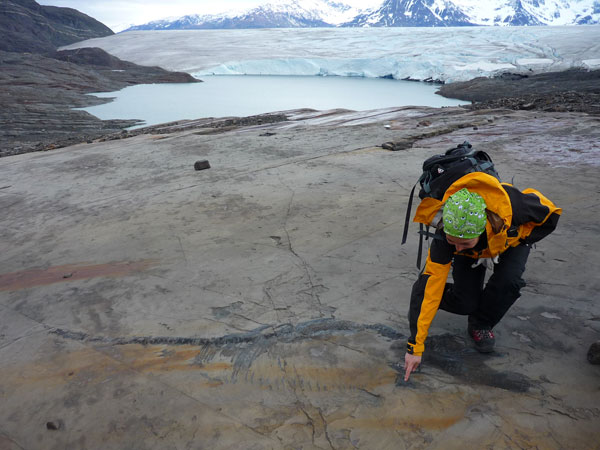
Picture credit: Alejandra Zúñiga
Finding and Rescuing “Fiona” the Pregnant Ichthyosaur
An expedition to the remote Tyndall Glacier located in the Torres del Paine National Park, led by Dr Judith Pardo-Pérez from the University of Magallanes (Punta Arenas, southern Chile), has recovered the country’s first complete ichthyosaur fossil. Nicknamed “Fiona” the four-metre-long specimen represents the remains of a pregnant female, complete with several ichthyosaur embryos.
“Fiona” was discovered in 2009, during an earlier expedition to this remote area of Chilean Patagonia. A team of dedicated researchers which included Jonatan Kaluza from Fundación de Historia Natural Félix de Azara and CONICET (Argentina), biologist and palaeontological excavator Héctor Ortiz from the Chilean Antarctic Institute and the University of Chile and renowned ichthyosaur expert Dr Dean Lomax (Visiting Scientist at The University of Manchester), braved the harsh conditions in March and April to ensure the safe removal of the specimen. The intact female ichthyosaur remains were airlifted using a helicopter. It is hoped that further analysis of this remarkable specimen will confirm it as a new ichthyosaur genus.
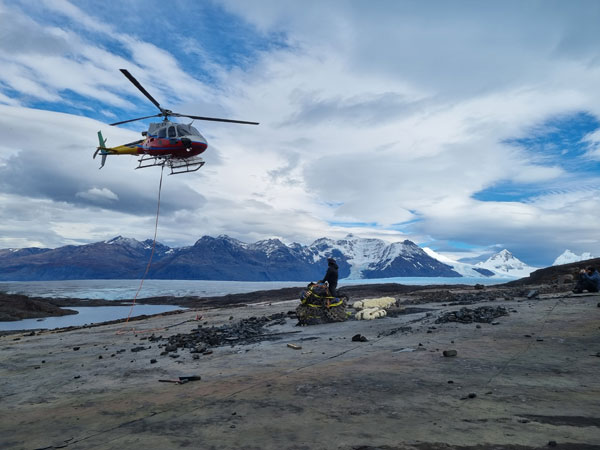
Picture credit: The University of Manchester
The First Female Palaeontologist to Lead a Major Expedition to Patagonia
Dr Judith Pardo-Pérez has visited the Tyndall fossil site more than ten times since the initial discovery in 1997 and completed her PhD on the ichthyosaurs found in the area. Thanks to funding from the Chilean National Agency for Research and Development (ANID), a team of top scientists could be put together to allow the fossils preserved in an ancient Cretaceous seabed to be studied in detail.
Dr Pardo-Pérez, is the first female palaeontologist to lead a major expedition in Patagonia.
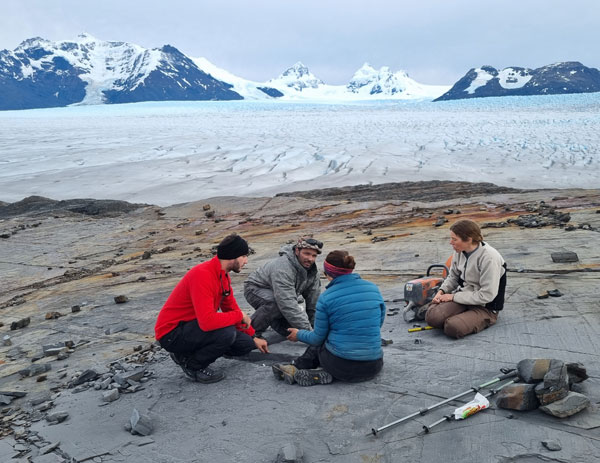
Picture credit: The University of Manchester
Collecting these hugely important marine reptile fossils, was no easy task. The Tyndall Glacier site could only be reached by a 10-hour hike or horse ride and the team had to endure difficult weather conditions including high winds and snowstorms whilst excavating the fossils from the extremely hard sediment.
To combat the 90 kph winds, heavy rain and snow, a hangar was built over “Fiona” so that the team could continue to work despite the harsh weather. Circular saws and heavy-duty excavation tools were used to free the fossils from the bedrock.
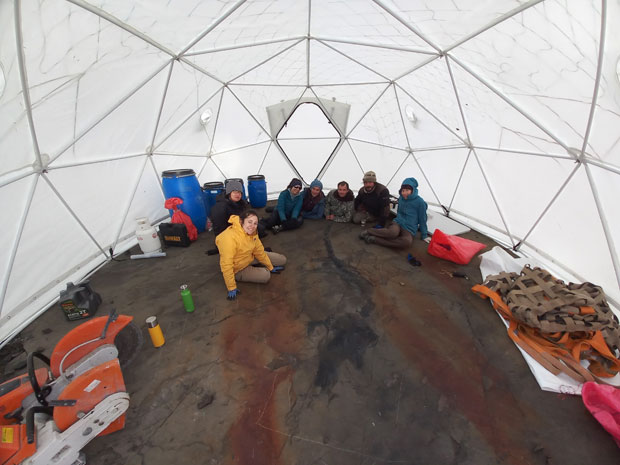
Picture credit: The University of Manchester
The Most Abundant and Best-preserved Cretaceous Ichthyosaur Deposit Known
Despite the constant threat of pumas, the team have ensured that this exceptional female specimen has been made available for further analysis and study. It is the only known specimen of a pregnant female of Valanginian-Hauterivian age (between 129 and 139 million years old from the Early Cretaceous).
Commenting on the importance of the specimen, Dr Pardo-Perez Pérez stated:
“At four metres long, complete, and with embryos in gestation, the excavation will help to provide information on its species, on the palaeobiology of embryonic development, and on a disease that affected it during its lifetime.”
In addition to “Fiona” a further twenty-three new ichthyosaur specimens were discovered by the expedition team, making the Tyndall Glacier site perhaps the most abundant and best-preserved early Cretaceous ichthyosaur deposit in the world.
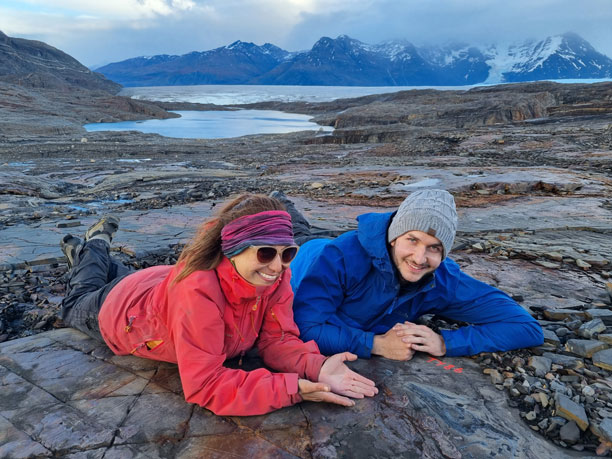
Picture credit: The University of Manchester
An Ichthyosaur Graveyard
The fossils consist of adults, juveniles and very young ichthyosaurs, they can provide scientists with information on breeding behaviour as well as helping to plot the radiation of new ichthyosaur genera following the end-Jurassic extinction event.
Dr Lomax explained:
“The fact that these incredible ichthyosaurs are so well preserved in an extreme environment, revealed by a retreating glacier, is unlike anywhere else in the world. The considerable number of ichthyosaurs found in the area, including complete skeletons of adults, juveniles, and new-borns provides a unique window into the past. The international collaboration helps to share this exceptional ichthyosaur graveyard with the world and, to a large extent, to promote science.”
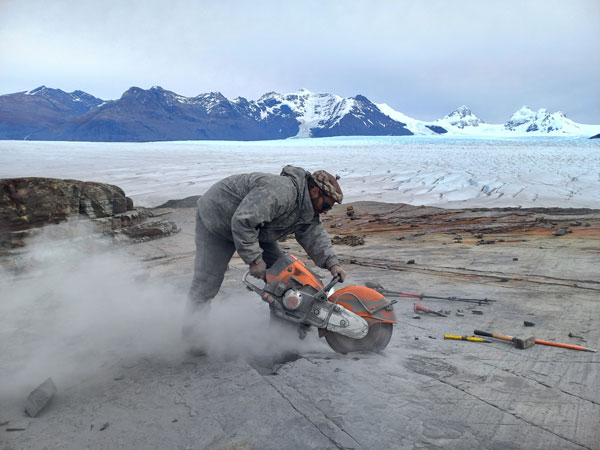
Picture credit: The University of Manchester
Dr Lomax added:
“The weather was so extreme that we could not get to the ichthyosaur site every day and had to remain in camp. On those days when the team could reach the site, they documented the ichthyosaurs and other fossils and discovered new specimens. Amazingly, on average, two ichthyosaurs were found every day.”
Protecting and Preserving the Remaining Specimens
The female ichthyosaur nicknamed “Fiona”, will be prepared and studied at the Río Seco Natural History Museum in Punta Arenas. It is hoped that the beautifully preserved specimen will go on public display.
The priority for Dr Pardo-Pérez and her collaborators is to try to preserve as many specimens as possible. The remoteness of the site and the difficult working conditions will hamper any attempts to preserve and protect these remarkable specimens.
Outlining some of the problems facing the team, the doctor stated:
“We have almost a hundred ichthyosaurs in the Tyndall Glacier fossil deposit and many of them, unfortunately, will never be excavated, due to the difficulty of access, being in risk areas [cliff edge], and lack of funds. The ichthyosaurs that will not be excavated need protection and consolidation in situ, as the erosion to which they are being subjected on a daily basis is destroying them.”
Everything Dinosaur acknowledges the assistance of media release from The University of Manchester in the compilation of this article.
The award-winning Everything Dinosaur website: Prehistoric Animal Models.

